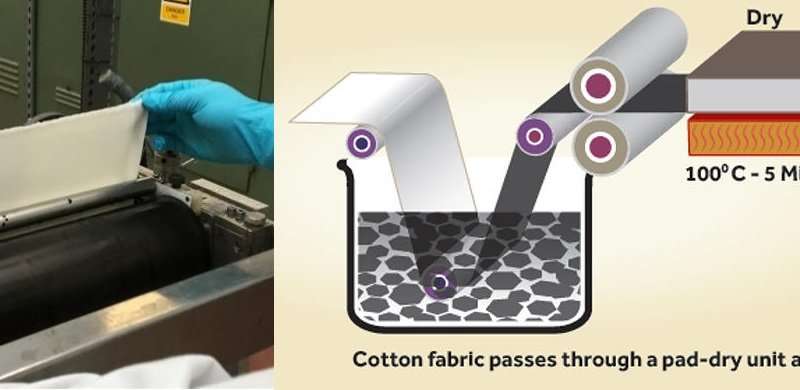

Contact: Manager Yang
Hotline: 950-4048-3964 (free)
Tel: 0510-85386636
Mobile: 18011518665
Shangmeng Technology Wuxi Co., Ltd.
Address: A1-602, Tianan Smart City, No. 228 Linghu Avenue, Xinwu District, Wuxi City, Jiangsu Province

According to IDTecjEX, the electronic textile market will reach $5 billion by 2027. Graphene is considered to be the leading product. However, graphene textiles have not yet been industrialized. Recently, Professor Kostya S. Novoselov of the University of Manchester in the UK developed a wearable graphene-based textile production line with a capacity of 150 meters per minute. The results were published in the ACS Nano.
The market for e-textile clothing is forecasted to reach $5 billion by 2027, according to the market research firm IDTechEX. And while graphene is expected to be one of the most prominent materials in wearable e-textiles, currently there is no good way to Manufacture graphene-based e-textiles on an industrial scale.
To address this problem, a team of researchers led by Professor Kostya S. Novoselov at The University of Manchester have developed a scalable process to manufacture graphene-based wearable e-textiles on an industrial scale . As they write in their paper published in a recent Issue of ACS Nano , the method could allow graphene e-textiles to be manufactured at commercial production rates of 150 meters per minute.
"To be able to produce graphene-based wearable e-textiles inScalable quantity at very high speed is a significant breakthrough for the continuous growing wearables market," first author Nazmul Karim at The University of Manchester told Phys.org . "Our simple and Cost-effective way of producing multifunctional graphene textiles could easily be scaled up for many real-life applications, such as sportswear, military gear, and medical clothing."
In the new method, the team has reversed the previous process of coating textiles with graphene-based materials. Traditionally, the textiles are first coated with graphene oxide , and then the graphene oxide is reduced to its functional form of reduced graphene oxide. Here the researchers first reduced the graphene oxide in solution, and then coated the textiles with the reduced form.
By making coating the final step, it becomes possible to use a coating technique called padding, which is currently the most commonly used method of applying functional finishes to textiles in the textile industry. For example, water-repellent and wrinkle-free clothing are often Made by padding.
A commercial pad-dry unit can process approximately 150 meters of fabric in just one minute—a huge leap from laboratory methods for coating textiles with graphene that often involved multiple time-consuming steps. As the researchers write in their paper, they believe that using Padding to manufacture graphene-based e-textiles will be an important step in moving from R&D-based e-textiles to real-world applications.
In their study, the researchers, the e-textiles made by a laboratory-scale pad-dry unit exhibit excellent electrical and mechanical characteristics. Tests showed that the reduced graphene oxide forms a uniform coating around the individual cotton fibers, which results in good electric Conductivity, tensile strength, breathability, flexibility, and overall comfort of the fabric. The coated fabric also appears to remain electrically conductive after repeated washing cycles.
One possibility, which the researchers demonstrated, is that sensors can be incorporated into the fabric for monitoring physical activity. A sensor mounted on the wrist, for example, can capture mechanical movements Such as bending/unbending, stretching/relaxation, and twisting/untwisting. Another possibility is to incorporate flexible heating elements throughout an item of clothing, along with flexible supercapacitors to power them.
"Our future research plan is to look into other 2D materials and utilize their benefits for wearable e-textiles applications," Karim said. "We are also looking to commercialize these technologies in collaboration with industrial partners."
![]() Explore further: Flexible batteries power the future of wearable technology
Explore further: Flexible batteries power the future of wearable technology
More information: Nazmul Karim et al. "Scalable Production of Graphene-Based Wearable E-Textiles." ACS Nano . DOI: 10.1021/acsnano.7b05921
Previous: At minus 45 degrees Celsius: scientists succeeded in creating the lowest temperature water
Address:Tianan Smart City A1-602, No. 228 Linghu Avenue, Xinwu District, Wuxi, Jiangsu, China TelePhone:0510-85386636 Fax:0510-85384339 E-mail:info@solmontech.com
KeyWord: